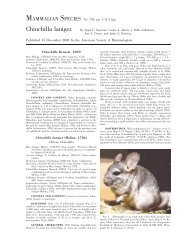Brugia Malayi - Clark Science Center - Smith College
Brugia Malayi - Clark Science Center - Smith College
Brugia Malayi - Clark Science Center - Smith College
Create successful ePaper yourself
Turn your PDF publications into a flip-book with our unique Google optimized e-Paper software.
Testate Amoebae and Discovering that Environment May Have an Effect<br />
on the Population of a Species<br />
Cameah Wood<br />
Testate amoebae are single celled microorganisms that dwell within bogs, near or in freshwater, soils, and some vegetation.<br />
These organisms are enclosed within shells that differ in shapes and sizes. In addition, they move and eat by using pseudopodia.<br />
(Pseudopodia are very important when identifying whether the amoebae being viewed under a microscope is alive.) Noticing the<br />
different physical characteristics of the testate amoebae is another very important characteristic when viewing testate amoebae.<br />
This helps to identify the species, until they are identified by their genetic make-up. Testate amoebae are important to science<br />
because they have the capabilities of helping scientists research and discover the climate conditions and changes within an area or<br />
habitat that can span over thousands of years. Over the period of time which I conducted research, I collected viewed, identified<br />
and classified testate amoebae from local bogs. This helped to spark ideas for future projects.<br />
When conducting research with testate amoebae, collecting is the beginning. Traveling to different local bogs such as Acadia,<br />
Harvard Forest, and Bear Swamp etc., has helped us to maximize the possibility of collecting an array of different species of<br />
testate amoeba. At the collection sites, we then look around for sphagnum moss. This type of vegetation, is where majority of<br />
testate amoebae dwell, this is due to the ph. levels existent within the moss. Testate amoebae thrive off of acidic vegetation such<br />
as the sphagnum moss. In addition to this, we also collect a sample of the water from the area which the sphagnum is located.<br />
From there we view our samples, make note of the number of species we find, mouth pipette them, genome amplify them, clone,<br />
sequence, and then proceed to analyze our results.<br />
After repeatedly doing this, many things were realized that there was a pattern within the species population within different<br />
sites. Within some sites for example, the testate amoebae Hyalosphinia Papillio may be more existent then in other places. After<br />
coming to that conclusion, the characteristics of the sites where identified. This identification can consist of whether or not<br />
location of a sample was higher up on a hill, dryer (where there was little to no water available to sample) etc. After looking at<br />
all the different characteristics there is a possibility that different conditions of the environment have effect on the population<br />
of a species within a site, and further research can be conduction on this topic. (Supported by Blakeslee Fund in the Biological<br />
<strong>Science</strong>s)<br />
Advisor: Laura Katz<br />
References:<br />
1 Microscopy-UK Micscape Microscopy and Microscopes Magazine. Microscopy-UK Micscape Microscopy and Microscopes Magazine. N.p., n.d. Web. 20 Aug. 2012.<br />
.<br />
2012<br />
61

















